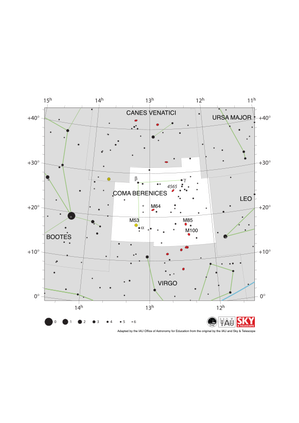Glossarbegriffe: Löwe
Description: Der Löwe (lateinisch Leo) ist ein Sternbild des Tierkreises. Das heißt, dass die Sterne dieses Sternbildes sich in dem Teil des Himmels befinden, der die Ekliptik schneidet. Die Ekliptik ist die Ebene, die durch die Umlaufbahnen der Planeten in unserem Sonnensystem definiert ist. Aus unserer Sicht hier auf der Erde können wir also regelmäßig die Planeten und auch die Sonne im Sternbild Löwe finden: Zum Beispiel befindet sich die Sonne jedes Jahr vom 11. August bis zum 17. September im Sternbild Löwe. (Während dieser Zeit können wir die Sterne des Sternbilds natürlich nicht sehen.) Am Nachthimmel ist Leo im Frühling am einfachsten zu beobachten. Er ist eines der 88 modernen Sternbilder, die von der Internationalen Astronomischen Union definiert wurden, und auch eines der 48 klassischen Sternbilder, die vom Astronomen Claudius Ptolemäus im 2. Jahrhundert beschrieben wurden. Der hellste der zahlreichen hellen Sterne des Löwen heißt Regulus.
Zugehörige Glossarbegriffe:
See this term in other languages
Term and definition status: The original definition of this term in English have been approved by a research astronomer and a teacher The translation of this term and its definition is still awaiting approval
The OAE Multilingual Glossary is a project of the IAU Office of Astronomy for Education (OAE) in collaboration with the IAU Office of Astronomy Outreach (OAO). The terms and definitions were chosen, written and reviewed by a collective effort from the OAE, the OAE Centers and Nodes, the OAE National Astronomy Education Coordinators (NAECs) and other volunteers. You can find a full list of credits here. All glossary terms and their definitions are released under a Creative Commons CC BY-4.0 license and should be credited to "IAU OAE".
If you notice a factual or translation error in this glossary term or definition then please get in touch.
Related Diagrams
Cancer Constellation Map
Bildnachweis: Adapted by the IAU Office of Astronomy for Education from the original by IAU/Sky & Telescope
License: CC-BY-4.0 Creative Commons Namensnennung 4.0 International (CC BY 4.0) icons
Leo Constellation Map
Bildnachweis: Adapted by the IAU Office of Astronomy for Education from the original by IAU/Sky & Telescope
License: CC-BY-4.0 Creative Commons Namensnennung 4.0 International (CC BY 4.0) icons
Virgo Constellation Map
Bildnachweis: Adapted by the IAU Office of Astronomy for Education from the original by IAU/Sky & Telescope
License: CC-BY-4.0 Creative Commons Namensnennung 4.0 International (CC BY 4.0) icons
Ursa Major Constellation Map
Bildnachweis: Adapted by the IAU Office of Astronomy for Education from the original by IAU/Sky & Telescope
License: CC-BY-4.0 Creative Commons Namensnennung 4.0 International (CC BY 4.0) icons
Coma Berenices Constellation Map
Bildnachweis: Adapted by the IAU Office of Astronomy for Education from the original by the IAU and Sky & Telescope
License: CC-BY-4.0 Creative Commons Namensnennung 4.0 International (CC BY 4.0) icons













